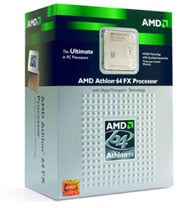AMD Athlon 64 FX-60 - Finally, An Enthusiast's Dual Core
Intel's launch of their next generation Pentium Extreme Edition 955 dual-core processor last month, marked a solid improvement in overall performance for what is to be the last core iteration utilizing the Pentium 4 Netburst architecture. While this Intel dual-core kicker, essentially beefing up a pair or Prescott dies in a single package, was a welcomed addition in performance and an impressive feat in 65nm process technology, thermal characteristics of the new Presler core Pentium were still pretty toasty and performance wasn't enough to catch AMD's high end Athlon 64 FX-57 or their Athlon 64 X2 4800+ dual core chip in many of our real world benchmark tests.
And today AMD lets fly with yet another volley of the dual-core persuasion, this time targeted squarely at the Enthusiast and Power User. While Intel's branding of their Pentium Extreme Edition dual-core CPU as "extreme" conjures up thoughts of best-in-class performance for the enthusiast, whether running multimedia apps, gaming or otherwise, it is painfully obvious that AMD's dual-core Athlon 64 X2 line-up is significantly more capable and well rounded in terms of performance. Regardless, AMD held off branding their high-end Athlon 64 X2 4800+ a true enthusiast dual core chip, leaving the "FX" moniker for the 2.8GHz single core Athlon 64 FX-57. With today's launch of the Athlon 64 FX-60 though, AMD is clearly positioning the new dual core as an all around high-end enthusiast class processor and with a pair of 2.6GHz Athlon 64 cores under the hood, essentially a pair of Athlon 64 FX-55 chips if you will, you could definitely speculate that their positioning is fair and accurate. But why speculate? That's why we're here. Read on, as we've put AMD's new Athlon 64 FX-60 to the test in the pages ahead.
|
| Dual Athlon 64 FX Cores Clocked at 2.6GHz AMD64 - When utilizing the AMD64 Instruction Set Architecture, 64-bit mode is designed to offer: _•_Support for 64-bit operating systems to provide full, transparent, and simultaneous 32-bit and 64-bit platform application multitasking. _•_A physical address space that can support systems with up to one terabyte of installed RAM, shattering the 4 gigabyte RAM barrier present on all current x86 implementations. _•_Sixteen 64-bit general-purpose integer registers (per core) that quadruple the general purpose register space available to applications and device drivers. _•_Sixteen 128-bit XMM registers (per core) for enhanced multimedia performance to double the register space of any current SSE/SSE2 implementation. Integrated DDR memory controller: _•_Allows for a reduction in memory latency, thereby increasing overall system performance. An advanced HyperTransport link: _•_This feature dramatically improves the I/O bandwidth, enabling much faster access to peripherals such as hard drives, USB 2.0, and Gigabit Ethernet cards. _•_HyperTransport technology enables higher performance due to a reduced I/O interface throttle. Large level one (L1) and level 2 (L2) on-die cache: _•_With 128 Kbytes of L1 cache and 1MB of L2 cache per core, the AMD Athlon 64 FX-60 and Athlon 64 X2 processors are able to excel at performing matrix calculations on arrays. _•_Programs that use intensive large matrix calculations will benefit from fitting the entire matrix in the L2 cache. 64-bit processing: _•_A 64-bit address and data set enables the processor to process in the terabyte space. _•_Many applications improve performance due to the removal of the 32-bit limitations. |
Processor core clock-for-clock improvements: _•_Including larger TLB (Translation Look-Aside Buffers) with reduced latencies and improved branch prediction through four times the number of bimodal counters in the global history counter, per core, as compared to seventh-generation processors. _•_These features drive improvements to the IPC, by delivering a more efficient pipeline for CPU-intensive applications. _•_CPU-intensive games benefit from these core improvements. _•_Introduction of the SSE2 instruction set, and now SSE3 (Rev. E and Athlon 64 X2) which along with support of 3DNow! Professional, (SSE and 3DNow! Enhanced) completes support for all industry standards. _•_32-bit instruction set extensions. Fab location: _•_AMD's Fab 30 wafer fabrication facility in Dresden, Germany Process Technology: _•_.09 micron SOI (silicon-on-insulator) Die Size: _•_Toldeo - 199mm2 Transistor count:  _•_Toldeo Core - Approximately 233.3 million Nominal Voltage: _•_1.40v |
Beyond the obvious clock speed boost, not much has changed with respect to the inner workings or architecture of the Athlon 64 FX-60, versus AMD's next fastest dual core CPU, the Athlon 64 X2 4800+. The only real difference between the two processors, other than their clock speeds, are the fact that the FX-60 has the ability to run at higher and lower core multipliers for added flexibility in overclocking. The Athlon 64 X2 4800+ can only have its multiplier lowered but not increased beyond its standard 12X setting. The Athlon 64 FX-60, however, comes with a standard core clock multiple of 13X and we were able to run it higher as well. We'll show you more details in this area shortly but the primary benefit for a higher core multiplier is the ability to leave system clock speeds and the memory controller clock speed, at their stock 200MHz setting, which allows memory timings to remain within specification while overclocking the CPU.






